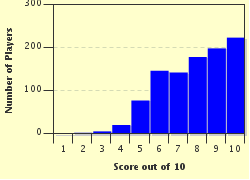Quiz Answer Key and Fun Facts
1. In "1984" (1949), George Orwell painted a vivid and terrifying picture of a future totalitarian state. By what name do the characters refer to the dictator who rules their lives?
2. Literary numbers aren't a new thing; in fact, numbers have been crucial to literature for millennia. In the title of Aeschylus's famous tragedy, produced for Athens' Dionysia festival in 467 BC, how many were arrayed "against Thebes"?
3. "The Nine Billion Names of God", by Arthur C. Clarke, is a very short story, but it turns the world upside-down and inside-out. The protagonists have been hired to help a customer with a new computer. Who is the customer?
4. Here's another numbered dystopian novel: Ray Bradbury's "Fahrenheit 451". To what does the book's title refer?
5. An enterprising author may try to pick up where another writer has left off, breathing new life into beloved characters and settings while receiving more-or-less free publicity. Yet, sometimes, the free-riding author is famous in her or his own right. One of the great writers of the 19th century deployed this very strategy with his story "The Thousand-and-Second Tale of Scheherazade". Who was he?
6. David Ebershoff reached the bestseller lists with "The 19th Wife," a novel blending two threads: the fictionalized account of a figure from 19th-century history, and the modern story of a fictional youth with a family in crisis. What religion is at the center of both stories?
7. "Slaughterhouse-Five" (1969), the book that made Kurt Vonnegut's name, tells the tale of a war veteran named Billy Pilgrim who has become "unstuck in time." To which of these World-War-II horrors is Billy a witness?
8. "A Thousand Splendid Suns" examines one family to explore the plight of Afghan women under Taliban rule. Who was its author, a man who first earned fame with an earlier novel that looked at Afghanistan through the lens of kites?
9. In 1968, Arthur C. Clarke took readers on "A Space Odyssey", centered on a set of strange monoliths with a deep connection to humanity's past and future. What year appears in the title of this influential book?
10. Shipwrecks are always good for a page-turner, but this one has a twist: the sole survivors are a boy and a Bengal tiger, and they're stuck in the same life raft. Which book hinges on this unusual premise?
Source: Author
CellarDoor
This quiz was reviewed by FunTrivia editor
looney_tunes before going online.
Any errors found in FunTrivia content are routinely corrected through our feedback system.

